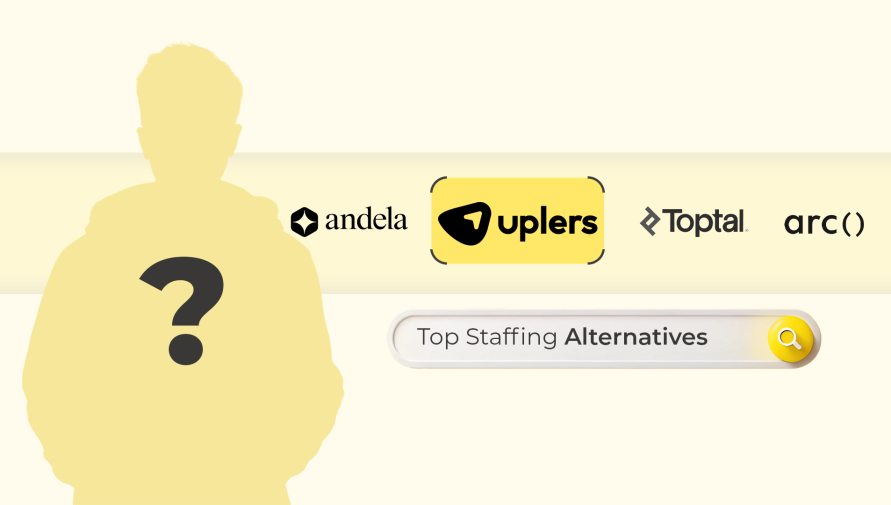How Staffing Alternatives Can Help You Overcome Talent Shortages
- Prachi Shah
- June 7, 2025
- 5 Minute Read

Finding qualified talent has become one of the biggest operational roadblocks for fast-scaling companies in 2025. This issue is particularly pressing in industries such as technology, healthcare, and engineering, where specialized expertise is critical.
Traditional recruitment methods alone are often insufficient to meet these needs as they struggle to keep up due to lengthy timelines, high costs, and geographic limitations. Enter staffing alternatives.
Staffing alternatives, such as outsourcing, remote work, and freelance talent, offer innovative solutions to bridge the talent gap. It provides companies with the agility to scale as needed in today’s fast-paced, competitive environment.
This blog explores how to overcome talent shortage through the strategic use of staffing alternatives. It highlights why tech companies are increasingly choosing to hire IT talent globally and why hiring employees from India has become a smart, cost-efficient move in the current market landscape.
Understanding Talent Shortages
A talent shortage occurs when the available workforce lacks the skills to meet industry demand. It is not just about headcount but also about capability gaps. In tech, this includes roles in cloud, cybersecurity, AI, and full-stack development.
Industries most affected include:
- Technology – Especially software, DevOps, and cybersecurity
- Healthcare – For digital health and data systems
- Financial Services – Requiring advanced analytics and regulatory tech
Talent shortages lead to slower project delivery, rising labor costs, and stalled innovation. Teams face increased burnout due to overextended workloads.
One way to overcome a talent shortage is to use a staffing alternative like offshore or remote hiring. Companies now hire IT talent from global hubs like India to plug skill gaps quickly. Understanding this shift is crucial for maintaining business momentum in a skill-constrained market.
What Are Staffing Alternatives?
A staffing alternative is any nontraditional method of sourcing and employing skilled professionals. It helps companies meet workforce demands without relying solely on permanent, in-house hiring.
There are several types of staffing alternatives, each suited to different project scopes and organizational needs.
1. Temporary Staffing
Temporary staffing allows companies to hire professionals for freelancing or for short-term assignments. This is best for seasonal-type projects held to urgent deadlines or very particular skill sets. It offers flexibility without long-term financial commitments.
2. Contract-to-Hire
In this model, candidates are initially hired on a contractual basis. They can be offered a permanent position following a trial period. Businesses can use this method to assess talent fit prior to committing to long-term projects.
3. Outsourcing
Outsourcing is assigning certain jobs or complete projects to a third-party company. Customer service, content creation, and IT services all make extensive use of this. Costs can be cut, and internal attention can be redirected to vital skills through outsourcing.
4. Remote and Global Talent Pools
Hiring worldwide expands the scope of special skillsets and low-cost markets for talents. Turing, Supersourcing, Uplers, and Lemon.io are good platforms connecting companies with pre-vetted talent from regions like India and Latin America.
For example, many companies hire remote talent by tapping into global expert hubs like India. The country offers a large pool of English-speaking, technically skilled professionals with strong experience in software development, cloud, and data roles.

Benefits of Staffing Alternatives in Addressing Talent Shortages
Staffing alternatives help companies solve workforce shortages without compromising quality or speed. Their advantages extend across four critical areas:
- Flexibility and Scalability: Businesses can expand or reduce team size based on real-time project needs without long-term commitments.
- Access to Specialized Skills: Global platforms provide niche experts in DevOps, AI, cybersecurity, and other high-demand roles that are often scarce locally.
- Faster Hiring Processes: Pre-vetted talent from platforms like Uplers, Lemon.io, and Supersourcing cuts hiring timelines significantly.
- Cost-Effectiveness: Hiring employees from India or Latin America allows access to top-tier professionals at more affordable salaries.
How Staffing Alternatives Can Help Your Business
Staffing alternatives provide more than short-term solutions. They offer structural advantages that help businesses stay resilient and future-ready. Here is how they support your organization:
- Bridging Immediate Skill Gaps: When internal teams lack specific expertise, staffing alternatives enable rapid deployment of talent to keep projects on track.
- Supporting Long-Term Workforce Planning: Contract-based or remote professionals allow companies to test capabilities before committing to permanent hires.
- Enhancing Diversity and Innovation: Hiring from global talent pools such as India introduces new perspectives, encourages innovation, and improves team performance.
- Reducing Burnout Among Existing Employees: Supplementing in-house staff with external talent prevents team overload, improves morale, and sustains productivity during peak phases.
Choosing the Right Staffing Alternative for Your Needs
Selecting the right staffing alternative begins with understanding your business goals, project scope, and internal team capacity. Without clarity, even the best solutions may fail to deliver impact.
To make an informed choice:
- Assess Your Business Requirements: Define the skills you need, the project timeline, and your desired level of oversight and flexibility.
- Partner with the Right Staffing Agency: Look for platforms with strong screening processes, global reach, and a proven track record in your domain.
- Evaluate ROI and Long-Term Impact: Go beyond hourly rates. Consider productivity, retention, scalability, and time saved.
This approach helps organizations hire IT talent effectively and understand how to overcome talent shortages strategically.
 Challenges and Considerations
Challenges and Considerations
While staffing alternatives offer agility and access, they also come with risks that must be managed proactively. Without the right controls, businesses may face delivery gaps, miscommunication, or legal issues.
Key considerations include:
- Potential Drawbacks of Staffing Alternatives: Challenges include time zone differences, limited integration with internal teams, and inconsistent performance without close supervision.
- How to Mitigate Risks: Establish clear KPIs, maintain regular communication, and use collaboration tools to keep remote professionals aligned.
- Ensuring Compliance and Quality: Work with agencies that handle contracts, NDAs, and IP protection. Platforms like Uplers and Toptal provide pre-vetted professionals with built-in compliance processes.
The Future of Staffing Alternatives
As business needs evolve, staffing is no longer just about filling roles; it’s about building agile, future-ready teams.
Trends Shaping the Staffing Industry
In 2025, staffing will be characterized by flexibility, diversity, and global access. With remote and hybrid working models having become the new normal, local markets no longer constrain talent search. This has further accelerated the adoption of staffing alternatives that cater to scalability.
Organizations are also putting in place diversity policies, with inclusive hiring seen as a driver of innovation. Alternative staffing models help increase access to a wider, diverse candidate pool.
The Role of Technology and AI in Staffing
Artificial intelligence is further changing recruitment by automating resume screening, role matching, and candidate evaluation, maximizing speed and accuracy.
Predictive analytics also helps staffing firms predict their hiring needs and identify workforce trends, increasing their capability in long-term talent planning. This, in turn, takes businesses from reactive hiring to real-time data-based proactive talent strategies.
Predictions for the Next Decade
The next decade will see deeper integration of AI, machine learning, and data analytics in staffing. Global hiring platforms will grow, offering seamless access to cross-border talent.
A stronger focus on skills over credentials will enable more inclusive and outcome-driven hiring. Companies that adopt these models early will gain a competitive edge in building agile, future-ready teams.

Conclusion
The future of staffing alternatives will be shaped by automation, global access, and skill-first hiring models. Remote work adoption continues to rise, enabling companies to tap into international markets with ease. This shift is driving demand for platforms that help hire IT talent across borders.
Artificial intelligence also changes recruitment by automating the screening process or analyzing and predicting the probability of job fit more accurately. Companies that have figured out how to overcome talent shortage issues will, therefore, prioritize flexibility, speed, and access to global expertise.
Looking to future-proof your hiring strategy? Partner with Uplers to access pre-vetted, remote-ready tech talent from India and beyond.









